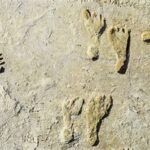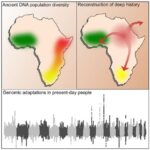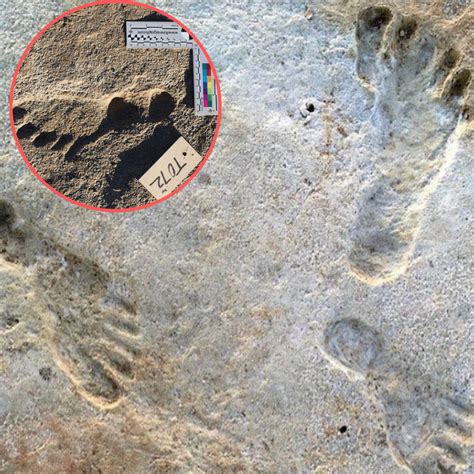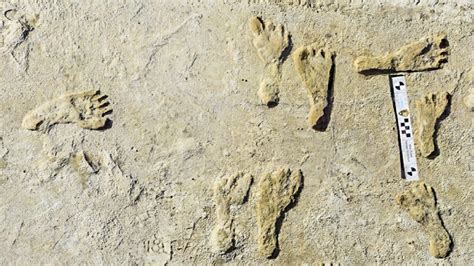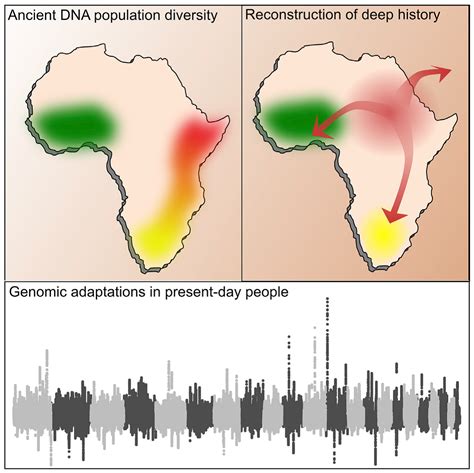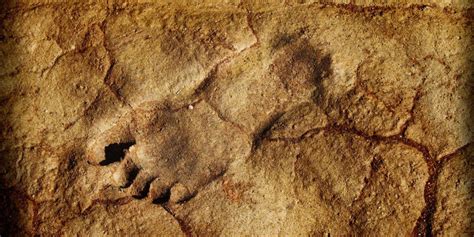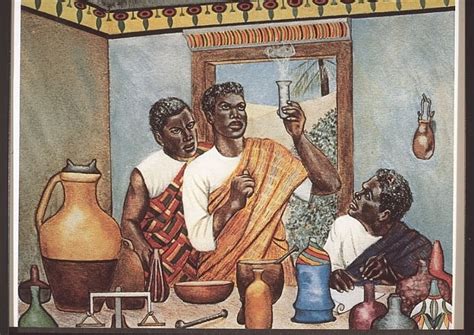
A groundbreaking genetic study reveals a previously unknown migration of ancient Africans into the Levant nearly 45,000 years ago, challenging existing narratives of early human dispersal and suggesting a more complex interaction between African and Eurasian populations than previously understood. The research, published in Nature Communications, unveils genetic evidence from the remains of individuals found in the Levant, indicating a substantial African influence predating the Neolithic period and the agricultural revolution.
Ancient Africans’ Surprising Journey Rewrites History
New genetic research is rewriting the story of early human migrations, revealing that ancient Africans ventured into the Levant region (modern-day Israel, Palestine, Lebanon, Jordan, and Syria) much earlier than previously thought. A study published in Nature Communications details the discovery of African ancestry in human remains dating back approximately 45,000 years, pushing back the timeline of African-Eurasian interaction significantly. This finding challenges the conventional understanding that significant African migration into the Levant occurred only during the Neolithic period with the advent of agriculture.
The research team, led by scientists from various international institutions, analyzed the genomes of ancient individuals from the Levant. Their analysis revealed a clear signal of African ancestry, indicating a migration event originating from Africa tens of millennia before the development of agriculture in the region. This suggests that the Levant was a meeting point for different human populations much earlier in history than previously believed.
“The data presented here demonstrate that a distinct African lineage was present in the Levant approximately 45,000 years ago,” the study authors state. “This challenges the assumption that the primary African influence in the region occurred solely with the spread of agriculture during the Neolithic.”
This discovery adds a new layer of complexity to the narrative of early human dispersal out of Africa. The traditional “Out of Africa” theory posits that modern humans originated in Africa and subsequently migrated to populate the rest of the world. While this theory remains a cornerstone of human evolutionary history, the new findings demonstrate that these migrations were not a one-time event but rather a series of complex movements and interactions over tens of thousands of years.
Genetic Evidence: A Window into the Past
The researchers extracted and analyzed ancient DNA from skeletal remains discovered at several archaeological sites in the Levant. These sites are known to contain human remains spanning different periods of prehistory, providing a valuable resource for understanding population movements and genetic changes over time. The process of extracting and analyzing ancient DNA is technically challenging, requiring specialized laboratory techniques to minimize contamination and ensure the accuracy of the results.
The genetic analysis focused on identifying specific genetic markers that are characteristic of African populations. By comparing the genomes of the ancient individuals from the Levant with those of modern and ancient populations from Africa and Eurasia, the researchers were able to detect a distinct African genetic signature in the Levantine remains. The presence of this signature provides strong evidence for an early migration event from Africa into the region.
The study employed advanced statistical methods to estimate the timing and magnitude of the African migration. These methods take into account the rate of genetic mutation and the patterns of genetic variation within and between populations. The results of the analysis suggest that the migration occurred approximately 45,000 years ago, predating the Neolithic period by several millennia.
Implications for Understanding Human History
The discovery of early African ancestry in the Levant has significant implications for our understanding of human history. It suggests that the Levant played a crucial role as a crossroads for different human populations, facilitating interactions and gene flow between Africa and Eurasia. This challenges the traditional view of the Levant as a passive recipient of migrations from other regions.
The findings also raise new questions about the nature of the interactions between the African migrants and the existing populations of the Levant. Did these groups coexist peacefully, or were there conflicts and competition for resources? Did they interbreed, and if so, to what extent? These are questions that future research will need to address.
Furthermore, the discovery highlights the importance of studying ancient DNA for reconstructing human history. Ancient DNA provides a direct window into the past, allowing researchers to observe genetic changes and population movements that are not apparent from archaeological or linguistic evidence alone. As more ancient DNA samples are analyzed, our understanding of human history is likely to become even more detailed and nuanced.
The study also underscores the complex relationship between genetic ancestry and cultural identity. While the ancient individuals from the Levant possessed African ancestry, they were also part of a distinct cultural context in the Levant. Their material culture, social practices, and beliefs may have differed significantly from those of their African ancestors. This reminds us that genetic ancestry is only one aspect of human identity and that cultural factors play an equally important role in shaping who we are.
Challenging Existing Models
This discovery directly challenges existing models of human migration and population dynamics. Previously, the main narrative placed significant African migration into the Levant much later, linked primarily to the spread of agriculture during the Neolithic period (around 10,000-4,500 years ago). The new evidence pushes this timeline back by tens of thousands of years, suggesting a far more ancient connection.
The study’s findings necessitate a re-evaluation of archaeological and anthropological interpretations of the Levant region. Researchers must now consider the potential influence of early African migrants on the cultural and technological developments of the region. This may involve re-examining existing archaeological sites and artifacts in light of the new genetic evidence.
Moreover, the discovery underscores the limitations of relying solely on archaeological and linguistic data for reconstructing human history. While these sources of information can provide valuable insights into past cultures and societies, they may not always accurately reflect the underlying genetic relationships between populations. Ancient DNA analysis provides a powerful tool for complementing and refining these traditional approaches.
Migration Routes and Timing
Determining the precise migration routes taken by the ancient Africans into the Levant is a key challenge for future research. Several possible routes have been proposed, including:
- The Sinai Peninsula: This is the most direct route from Africa to the Levant, involving crossing the Sinai Peninsula and entering the region through modern-day Egypt and Israel.
- The Red Sea: Another possibility is that the migrants crossed the Red Sea into the Arabian Peninsula and then moved north into the Levant.
- The Nile Valley: A third possibility is that the migrants followed the Nile Valley northward and then crossed into the Levant through modern-day Egypt.
The exact timing of the migration is also subject to further investigation. While the genetic evidence suggests that it occurred approximately 45,000 years ago, more precise dating methods may be able to refine this estimate. It is also possible that the migration was not a single event but rather a series of smaller migrations over a longer period of time.
Impact on Later Populations
The impact of the early African migrants on later populations in the Levant is another important area for future research. Did their genes persist in the region, or were they replaced by later migrants? Did they contribute to the development of agriculture and other technological innovations?
One possibility is that the early African migrants were largely replaced by later populations from Eurasia. However, it is also possible that their genes persisted in the region at low levels, contributing to the genetic diversity of later populations. It may be possible to trace the legacy of these early migrants by analyzing the genomes of modern populations in the Levant and searching for genetic markers that are characteristic of African ancestry.
Furthermore, it is possible that the early African migrants contributed to the development of agriculture and other technological innovations in the Levant. While agriculture is generally believed to have originated in the Fertile Crescent, it is possible that the early African migrants brought with them knowledge and skills that contributed to its development. This is a hypothesis that can be tested through further archaeological and genetic research.
Future Research Directions
The discovery of early African ancestry in the Levant opens up many new avenues for research. Some of the key questions that future research will need to address include:
- What were the specific migration routes taken by the ancient Africans into the Levant?
- What was the nature of the interactions between the African migrants and the existing populations of the Levant?
- What was the impact of the early African migrants on later populations in the Levant?
- How does this discovery change our understanding of the “Out of Africa” theory and the dispersal of modern humans?
- What can ancient DNA tell us about the cultural and social practices of the early African migrants?
To answer these questions, researchers will need to analyze more ancient DNA samples from the Levant and surrounding regions. They will also need to integrate genetic data with archaeological, linguistic, and anthropological evidence to create a more comprehensive picture of human history.
“Further research is needed to fully understand the extent of the African influence on the genetic makeup and cultural development of the Levant,” the study authors acknowledge. “The findings presented here serve as a catalyst for future investigations into the complex history of human migrations and interactions in this critical region.”
The study emphasizes the importance of interdisciplinary collaboration in unraveling the mysteries of human history. Geneticists, archaeologists, anthropologists, and linguists all have unique perspectives and expertise to contribute to this endeavor. By working together, these researchers can piece together a more complete and accurate picture of our past.
Wider Implications for Human Evolutionary Studies
The implications of this discovery extend beyond the Levant and have broader relevance for human evolutionary studies. It highlights the importance of considering multiple migration events and complex interactions between populations when reconstructing human history. The traditional “Out of Africa” theory, while fundamentally correct, needs to be refined to account for the dynamic and multifaceted nature of human dispersal.
The study also underscores the importance of preserving and studying ancient DNA. Ancient DNA provides a unique window into the past, allowing researchers to directly observe genetic changes and population movements that are not apparent from other sources of evidence. As more ancient DNA samples are analyzed, our understanding of human history is likely to become even more detailed and nuanced.
Moreover, the discovery highlights the importance of engaging with diverse perspectives and challenging existing assumptions in human evolutionary studies. The field has historically been dominated by researchers from Western countries, and it is important to ensure that researchers from other regions are also given the opportunity to contribute their knowledge and expertise. By fostering a more inclusive and collaborative research environment, we can accelerate our understanding of human history and evolution.
Conclusion
The discovery of early African ancestry in the Levant is a significant breakthrough that challenges existing narratives of human migration and population dynamics. It demonstrates that the Levant was a meeting point for different human populations much earlier in history than previously believed, and it raises new questions about the nature of the interactions between these groups. The findings highlight the importance of studying ancient DNA for reconstructing human history and underscore the complex and dynamic nature of human dispersal out of Africa. Further research is needed to fully understand the implications of this discovery, but it is clear that it will have a lasting impact on our understanding of human history and evolution. The study serves as a powerful reminder of the interconnectedness of human populations and the importance of studying our shared past.
Frequently Asked Questions (FAQ)
1. What is the main finding of this study?
The study’s main finding is the discovery of African ancestry in human remains from the Levant (modern-day Israel, Palestine, Lebanon, Jordan, and Syria) dating back approximately 45,000 years. This indicates a previously unknown migration of ancient Africans into the region, predating the Neolithic period and agricultural revolution.
2. How does this discovery challenge existing historical narratives?
Previously, it was believed that significant African migration into the Levant occurred primarily during the Neolithic period with the spread of agriculture. This new evidence pushes back the timeline of African-Eurasian interaction by tens of thousands of years, suggesting a far more ancient connection and challenging the assumption that the primary African influence in the region occurred solely with the spread of agriculture.
3. What kind of evidence supports this finding?
The finding is supported by genetic analysis of ancient DNA extracted from skeletal remains discovered at archaeological sites in the Levant. The researchers identified specific genetic markers characteristic of African populations in these remains, indicating a clear signal of African ancestry.
4. Where did these ancient Africans likely migrate from, and what routes might they have taken?
While the exact origin and routes are still under investigation, the ancient Africans likely migrated from Northeast Africa. Possible routes include:
- The Sinai Peninsula: The most direct route.
- The Red Sea: Crossing into the Arabian Peninsula and moving north.
- The Nile Valley: Following the Nile northward and crossing into the Levant.
5. What are the implications of this discovery for understanding human history and the “Out of Africa” theory?
This discovery adds a new layer of complexity to the narrative of early human dispersal out of Africa. It suggests that the Levant played a crucial role as a crossroads for different human populations, facilitating interactions and gene flow between Africa and Eurasia. The traditional “Out of Africa” theory, while still valid, needs to be refined to account for the dynamic and multifaceted nature of human dispersal, involving multiple migration events and complex interactions between populations over tens of thousands of years. The study highlights the importance of studying ancient DNA to reconstruct human history and underscores the interconnectedness of human populations and the importance of studying our shared past.
Further Elaboration and Contextualization
To provide a more comprehensive understanding of the study and its implications, it is essential to delve into several key areas in greater detail:
The Significance of the Levant Region
The Levant, situated at the crossroads of Africa, Asia, and Europe, has historically served as a critical corridor for human migration and cultural exchange. Its geographical location has made it a vital region for understanding the dispersal of early humans out of Africa and their subsequent interactions with populations in other parts of the world. The region’s rich archaeological record, spanning hundreds of thousands of years, provides a valuable resource for studying the evolution of human behavior, technology, and social organization.
The Levant is also significant for its role in the development of agriculture and settled lifestyles. The region is home to some of the earliest known agricultural sites, dating back over 10,000 years. The transition from hunting and gathering to agriculture had a profound impact on human societies, leading to increased population densities, the development of villages and towns, and the emergence of complex social hierarchies. Understanding the role of the Levant in this transition is crucial for understanding the origins of modern civilization.
The Challenges of Analyzing Ancient DNA
Analyzing ancient DNA (aDNA) is a technically challenging endeavor due to the degradation of DNA over time. Environmental factors such as temperature, humidity, and exposure to microorganisms can damage DNA molecules, making them fragmented and difficult to analyze. Contamination from modern DNA is also a significant concern, as even small amounts of modern DNA can skew the results of aDNA analysis.
To overcome these challenges, researchers employ specialized laboratory techniques and rigorous quality control procedures. These include:
- Working in dedicated clean rooms: To minimize contamination from modern DNA, aDNA analysis is typically conducted in dedicated clean rooms with controlled air flow and strict access protocols.
- Using specialized extraction methods: To extract DNA from ancient bones and teeth, researchers use specialized methods that minimize damage to the DNA molecules.
- Employing high-throughput sequencing technologies: To analyze the fragmented aDNA, researchers use high-throughput sequencing technologies that can generate millions of DNA sequences in a single experiment.
- Applying statistical methods to control for contamination: To identify and remove contaminated sequences, researchers use statistical methods that compare the aDNA sequences to those of modern humans and other potential sources of contamination.
Despite these challenges, aDNA analysis has become an increasingly powerful tool for studying human history and evolution. The development of new technologies and techniques is constantly improving the accuracy and reliability of aDNA analysis, allowing researchers to gain new insights into the past.
Specific Genetic Markers and Ancestry Inference
The identification of African ancestry in the ancient Levantine individuals relies on the analysis of specific genetic markers that are more common in African populations than in other populations. These markers include single nucleotide polymorphisms (SNPs), which are variations in a single DNA base pair. By comparing the frequencies of these SNPs in the ancient Levantine individuals to those in modern and ancient populations from Africa and Eurasia, the researchers were able to infer the presence of African ancestry.
The process of ancestry inference is complex and requires careful statistical analysis. Researchers use sophisticated algorithms and statistical models to estimate the proportion of ancestry that an individual derives from different ancestral populations. These models take into account the patterns of genetic variation within and between populations, as well as the rate of genetic mutation.
It is important to note that ancestry inference is not an exact science. The results of ancestry inference analyses are probabilistic estimates, and there is always some degree of uncertainty associated with them. However, by analyzing a large number of genetic markers and using rigorous statistical methods, researchers can obtain reliable estimates of ancestry.
The Neolithic Revolution and its Impact on Human Migration
The Neolithic Revolution, which began around 10,000 years ago, marked a profound shift in human history. The development of agriculture and animal domestication allowed humans to produce their own food, leading to increased population densities, the development of settled villages and towns, and the emergence of complex social hierarchies.
The Neolithic Revolution also had a significant impact on human migration patterns. As agriculture spread from its origins in the Fertile Crescent, it led to the expansion of farming populations into new territories. This expansion often involved the displacement or assimilation of existing hunter-gatherer populations.
The traditional view has been that the Neolithic Revolution was the primary driver of African migration into the Levant. However, the new findings challenge this view, suggesting that there was a significant African presence in the region long before the development of agriculture.
The Importance of Interdisciplinary Research
The study highlights the importance of interdisciplinary research in unraveling the mysteries of human history. Geneticists, archaeologists, anthropologists, and linguists all have unique perspectives and expertise to contribute to this endeavor. By working together, these researchers can piece together a more complete and accurate picture of our past.
For example, genetic data can provide insights into the genetic relationships between populations, while archaeological data can provide information about their material culture, technology, and social organization. Anthropological data can provide insights into their social and cultural practices, and linguistic data can provide information about their language and communication.
By integrating these different sources of information, researchers can create a more comprehensive understanding of human history and evolution. This interdisciplinary approach is essential for addressing complex questions such as the origins of agriculture, the dispersal of modern humans, and the development of human societies.
Ethical Considerations in Ancient DNA Research
Ancient DNA research raises a number of ethical considerations that must be carefully addressed. These include:
- Respect for the dead: Ancient human remains should be treated with respect and dignity. Researchers should consult with descendant communities and stakeholders before conducting any destructive analysis on ancient remains.
- Data privacy and security: Ancient DNA data can reveal sensitive information about individuals and populations, including their genetic ancestry, health status, and predisposition to certain diseases. Researchers should take steps to protect the privacy and security of this data.
- Intellectual property rights: Ancient DNA data can be used to develop new technologies and products, such as diagnostic tests and personalized medicines. It is important to ensure that the benefits of these technologies are shared equitably with all stakeholders.
- Community engagement: Researchers should engage with descendant communities and other stakeholders throughout the research process, from the planning stages to the dissemination of results. This engagement should be based on principles of transparency, mutual respect, and informed consent.
By addressing these ethical considerations, researchers can ensure that ancient DNA research is conducted in a responsible and ethical manner.



